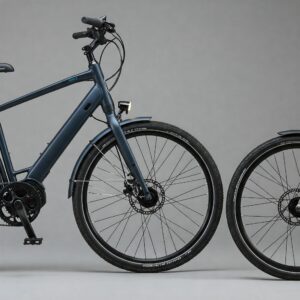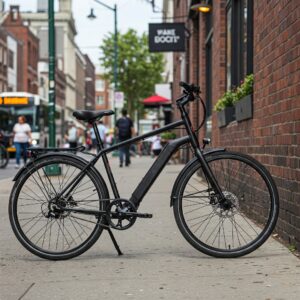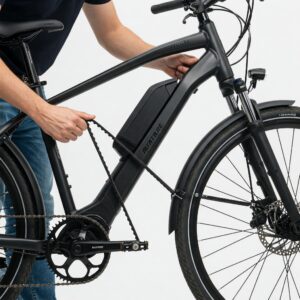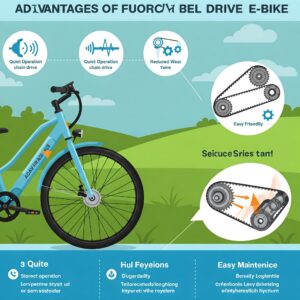Why Belt Drive Ebikes Are Gaining Popularity 🚀
Are you tired of noisy, messy, and high-maintenance chain drives on your electric bicycle? If so, a belt drive ebike might be exactly what you need to elevate your riding experience. Belt drive ebikes have been steadily gaining popularity among cycling enthusiasts and commuters alike. In fact, I’ve noticed that more riders are making the switch to these innovative machines for their daily transportation needs. The belt drive ebike offers a unique combination of reliability, cleanliness, and quiet operation that traditional chain-driven bikes simply can’t match.
When I first discovered belt drive ebikes, I was immediately impressed by their smooth performance and minimal maintenance requirements. Unlike conventional chain systems that require regular greasing and cleaning, belt drive systems provide a hassle-free riding experience. Additionally, these sophisticated ebikes deliver a silent ride that enhances your connection with the environment around you. Whether you’re commuting through busy city streets or exploring scenic trails, a belt drive ebike offers an unparalleled riding experience.
What Exactly Is a Belt Drive Ebike? ⚙️
A belt drive ebike is an electric bicycle that uses a belt drive system instead of the traditional metal chain to transfer power from the pedals to the rear wheel. The belt itself is typically made from carbon fiber-reinforced rubber, creating a strong yet flexible connection between the front and rear sprockets.
Key Components of a Belt Drive System:
✅ Carbon fiber-reinforced belt: Durable and maintenance-free
✅ Front sprocket: Connected to the pedals or motor
✅ Rear sprocket: Attached to the rear wheel hub
✅ Tensioning system: Keeps the belt at optimal tightness
Unlike metal chains that require regular lubrication and cleaning, belt drives operate cleanly without the need for grease. This simple yet sophisticated design difference creates several advantages that make belt drive ebikes increasingly popular among various types of riders.

The Compelling Benefits of Choosing a Belt Drive Ebike 🌟
Whisper-Quiet Operation 🤫
One of the most noticeable benefits when riding a belt drive ebike is the nearly silent operation. The first time I rode one, I was amazed by how the typical chain noise was completely eliminated. This quiet ride allows you to enjoy your surroundings more fully, whether you’re commuting through city streets or exploring nature trails. Without the clicking and clacking of a metal chain, you can focus on the journey rather than being distracted by mechanical noise.
Extraordinary Durability and Longevity ⏱️
Belt drives are engineered to last significantly longer than traditional chains. While a typical bike chain might need replacement every 2,000-3,000 miles, a quality belt drive can often last 10,000-20,000 miles before requiring replacement. This exceptional longevity translates to fewer replacement parts and reduced maintenance costs over the lifetime of your ebike.
Maintenance-Free Convenience ✨
Perhaps the most appreciated advantage of belt drive ebikes is their minimal maintenance requirements. Consider these maintenance differences:
Traditional chain drive:
- Regular cleaning to remove dirt and debris
- Frequent lubrication to prevent rust and ensure smooth operation
- Periodic adjustments to maintain proper tension
- Replacement every few thousand miles
Belt drive:
- No lubrication required
- Resistant to dirt, mud, and environmental contaminants
- Minimal tension adjustments needed
- Significantly longer replacement intervals
For busy commuters or weekend adventurers who prefer riding over maintenance, this convenience factor alone makes belt drive ebikes worth considering.
Clean Operation Without Grease or Mess 🧼
Have you ever arrived at your destination with chain grease on your pants or hands? With a belt drive ebike, this common cycling inconvenience becomes a thing of the past. The belt drive operates without any lubrication, eliminating the risk of grease stains on your clothing. This clean operation is particularly valuable for commuters who ride to work or social events in their regular clothes.
Smooth and Consistent Power Transfer 🔄
Belt drives provide a remarkably smooth power transfer from the motor and pedals to the rear wheel. The consistent tension and lack of metal-on-metal contact points create a riding experience that feels more refined and responsive. Many riders report that this smooth power delivery makes the ebike feel more natural and intuitive to ride, especially when transitioning between pedal assistance levels.
Potential Drawbacks to Consider Before Purchasing 🤔
Premium Price Point 💰
The sophisticated technology and materials used in belt drive systems typically result in a higher initial purchase price. Belt drive ebikes generally cost more than their chain-driven counterparts, with the price difference ranging from $200 to $800 depending on the model and brand. However, many riders find that the long-term savings on maintenance and replacement parts help offset this higher upfront investment.
Limited Gear Options 🔄
Most belt drive systems are designed to work with internal gear hubs rather than traditional derailleurs. While this provides excellent reliability and protection from the elements, it sometimes means fewer gear options compared to conventional multi-speed chain systems. For riders who frequently tackle varied terrain with extreme elevation changes, this limitation might be a consideration.
Specialized Repair Requirements 🛠️
When maintenance or repairs are eventually needed, belt drive systems often require specialized knowledge and tools. Not all local bike shops have experience working with belt drives, which might mean traveling farther for service or learning to perform some maintenance tasks yourself. However, as belt drive systems become more popular, service availability continues to improve in many areas.
Top Belt Drive Ebike Models for 2025 🏆
After testing numerous models and researching customer experiences, I’ve compiled a list of the most impressive belt drive ebikes currently available. Each offers unique features to suit different riding styles and preferences.
1. For Urban Commuters: Priority Current E-Bike
The Priority Current stands out as an exceptional commuter-focused belt drive ebike. With its sleek design and integrated lighting system, this model is perfect for navigating city streets in style. The Current features a powerful mid-drive motor paired with a smooth-shifting internal gear hub, creating an effortless riding experience even on hilly terrain.
Key specifications:
- Motor: 500W mid-drive
- Range: 30-60 miles per charge
- Belt: Gates Carbon Drive CDX
- Gearing: Enviolo stepless internal hub
- Integrated features: Front and rear lights, fenders, rear rack compatibility
2. For Trail Enthusiasts: Specialized Turbo Vado SL
For those who like to venture beyond paved roads, the Specialized Turbo Vado SL offers a compelling blend of off-road capability and refined belt drive technology. This lightweight ebike provides natural-feeling pedal assistance that enhances rather than dominates your riding experience.
Key specifications:
- Motor: Specialized SL 1.1, 240W mid-drive
- Range: Up to 80 miles with range extender
- Belt: Custom carbon belt drive
- Weight: Approximately 33 lbs (one of the lightest ebikes available)
- Suspension: Front suspension fork with 80mm travel
3. For Cargo Hauling: Tern GSD S00 LX

The Tern GSD S00 LX redefines what’s possible with a cargo-oriented belt drive ebike. Despite its compact wheelbase, this remarkable model can carry up to 440 lbs including rider and cargo. The maintenance-free belt drive makes this an ideal choice for daily use in all weather conditions.
Key specifications:
- Motor: Bosch Cargo Line, 85Nm torque
- Range: Up to 70 miles (dual battery option)
- Belt: Gates Carbon Drive
- Cargo capacity: 440 lbs total (rider + cargo)
- Features: Integrated rack system, optional passenger seating
4. For Budget-Conscious Riders: Ride1Up Prodigy XC
The Ride1Up Prodigy XC proves that quality belt drive technology doesn’t have to break the bank. While still representing an investment, this model offers exceptional value with components typically found on much more expensive ebikes.
Key specifications:
- Motor: Brose TF mid-drive, 90Nm torque
- Range: 30-50 miles per charge
- Belt: Gates CDN belt drive
- Frame: Aluminum alloy with internal cable routing
- Features: Hydraulic disc brakes, front suspension, integrated lights
5. For Long-Distance Touring: Riese & Müller Charger3
The Riese & Müller Charger3 is designed for riders who want to go the distance. With optional dual-battery technology and premium components throughout, this belt drive ebike excels at extended tours and multi-day adventures.
Key specifications:
- Motor: Bosch Performance Line CX Gen4
- Range: Up to 100+ miles with dual battery
- Belt: Gates Carbon Drive CDX
- Suspension: Full suspension with 100mm travel
- Features: Integrated anti-theft technology, touring-oriented ergonomics
6. For Folding Convenience: Brompton Electric
The Brompton Electric combines the iconic folding design with modern electric assistance and a clean belt drive. Perfect for multi-modal commuters who combine cycling with public transport or car travel.
Key specifications:
- Motor: 250W front hub motor
- Range: 20-45 miles depending on assistance level
- Belt: Custom belt drive system
- Folded dimensions: 23″ × 22.2″ × 10.6″
- Weight: Approximately 30-32 lbs (depending on configuration)
7. For Stylish City Riding: Gazelle Ultimate C8+ HMB
The Gazelle Ultimate C8+ HMB perfectly balances elegant European styling with practical features. The belt drive system complements the bike’s refined aesthetic while providing the reliability needed for daily use.
Key specifications:
- Motor: Bosch Performance Line mid-drive
- Range: 40-55 miles per charge
- Belt: Gates Carbon Drive
- Gearing: Shimano Nexus 8-speed internal hub
- Features: Integrated lights, fenders, rack, suspension seatpost
Comparison of Top Belt Drive Ebike Models
| Model | Best For | Motor Type | Range | Price Range |
|---|---|---|---|---|
| Priority Current | Urban Commuting | 500W Mid-drive | 30-60 miles | $3,299-$3,799 |
| Specialized Turbo Vado SL | Trail Riding | 240W Mid-drive | Up to 80 miles | $4,000-$5,500 |
| Tern GSD S00 LX | Cargo Hauling | Bosch Cargo Line | Up to 70 miles | $5,499-$5,999 |
| Ride1Up Prodigy XC | Value Buyers | Brose TF Mid-drive | 30-50 miles | $2,295-$2,595 |
| Riese & Müller Charger3 | Touring | Bosch Performance CX | 60-100+ miles | $5,799-$7,500 |
| Brompton Electric | Folding/Multimodal | 250W Front Hub | 20-45 miles | $3,550-$3,950 |
| Gazelle Ultimate C8+ HMB | Stylish City Riding | Bosch Performance | 40-55 miles | $3,999-$4,499 |
Ready to experience the smooth, silent advantage of a belt drive ebike? Click on any of our recommended models above to check current pricing and availability on Amazon. Your perfect ride is just a click away! ⚡

Key Factors to Consider When Choosing Your Belt Drive Ebike 🔍
Drive System Power and Torque 💪
The motor is the heart of any ebike, and belt drive models are available with various power configurations:
- Hub motors: Typically simpler and less expensive, these motors are built into the wheel hub
- Mid-drive motors: Positioned at the bicycle’s bottom bracket, these provide better weight distribution and more efficient power transfer
When evaluating motor specifications, pay particular attention to torque ratings (measured in Newton meters or Nm) rather than just wattage. Higher torque translates to better hill-climbing ability and stronger acceleration, especially when carrying cargo or riding through challenging terrain.
Battery Capacity and Range 🔋
Battery capacity is typically measured in watt-hours (Wh), with higher numbers indicating greater potential range. However, actual range depends on multiple factors:
- Rider weight
- Terrain (hills vs. flat)
- Assistance level used
- Weather conditions (wind, temperature)
- Riding style
For commuting purposes, I recommend choosing a belt drive ebike with enough range to complete your round-trip journey using moderate assistance, with at least 20-30% battery reserve. This provides a safety margin for unexpected detours or changing conditions.
Frame Design and Riding Position 🧍
Belt drive ebikes come in various frame styles, each offering different riding positions:
- Step-through frames: Easier mounting and dismounting, ideal for urban riding
- Step-over frames: Traditional diamond shape, typically providing more stiffness
- Mixte frames: A middle ground between the above options
Your ideal frame depends on your flexibility, riding purposes, and personal preferences. For commuting, a more upright position often provides better visibility in traffic and greater comfort, while a more aggressive position might be preferred for faster recreational riding.
Integration of Components and Accessories 🧩
The best belt drive ebikes feature thoughtful integration of essential components:
- Lighting: Integrated, battery-powered lights provide safety without the need for separate batteries
- Racks and cargo options: Built-in or easily compatible carrying solutions for commuting needs
- Fenders: Protection from road spray in wet conditions
- Security features: Some premium models include integrated locks or anti-theft technology
When comparing models, consider which accessories would need to be added afterward versus what comes included, as this affects the total cost of ownership.
Maintenance Tips for Belt Drive Ebike Owners 🛠️
While belt drive systems require significantly less maintenance than chains, some periodic attention will maximize performance and longevity:
Regular Belt Tension Checks ✅
Proper tension is crucial for optimal belt drive performance. Unlike chains that can operate with some slack, belt drives need to maintain specific tension to function correctly. Most manufacturers provide tension specification tools or recommendations:
- Check tension monthly or after any significant impact
- Follow manufacturer’s specifications precisely
- If adjustment is needed, consult your owner’s manual for the specific procedure
Cleaning Practices 🧽
One of the joys of belt drive ownership is the minimal cleaning required:
- Rinse with water to remove dirt and debris
- No degreasing or lubrication needed
- Inspect for any embedded objects that could damage the belt
- Wipe dry after riding in wet conditions
Belt Alignment Monitoring 📏
Proper alignment between the front and rear sprockets ensures optimal performance and belt life:
- Visually inspect the belt to ensure it runs straight between sprockets
- Listen for any unusual noises during operation
- If misalignment is suspected, have it professionally adjusted
Battery Care for Longevity 🔋
While not specific to the belt drive system, proper battery care maximizes the lifespan of your ebike’s most expensive component:
- Avoid completely draining the battery when possible
- Store at approximately 40-80% charge if not using for extended periods
- Keep the battery at moderate temperatures (avoid extreme heat or cold)
- Use the manufacturer’s recommended charger
Belt Drive Ebikes vs. Chain Drive Ebikes: A Detailed Comparison 🔄
To help you make an informed decision, let’s compare belt drive ebikes directly against their chain-driven counterparts across several key categories:
Noise Level 🔊
- Belt Drive: Nearly silent operation, with only tire and wind noise being noticeable
- Chain Drive: Produces mechanical clicking and occasional rattling, especially as the chain wears
Maintenance Requirements 🧰
- Belt Drive: Occasional tension checks, no lubrication, typical life of 10,000-20,000 miles
- Chain Drive: Regular cleaning and lubrication every 200-300 miles, tension adjustments, replacement every 2,000-3,000 miles
Cleanliness 🧼
- Belt Drive: No grease or lubricant, stays clean in all conditions
- Chain Drive: Requires regular lubrication that can attract dirt and transfer to clothing and hands
Weight Difference ⚖️
- Belt Drive: Typically 200-300g heavier than a chain system due to the belt’s construction and specific frame requirements
- Chain Drive: Lighter overall system but requires more peripheral components (derailleurs, etc.)
Cost Considerations 💰
- Belt Drive: Higher initial purchase price ($200-$800 premium) but lower lifetime maintenance costs
- Chain Drive: Lower upfront cost but higher ongoing maintenance expenses
Efficiency in Power Transfer ⚡
- Belt Drive: 96-98% efficiency when properly tensioned
- Chain Drive: 95-98% efficiency when clean and well-maintained, but decreases as the chain gets dirty or wears
Frequently Asked Questions About Belt Drive Ebikes ❓

How long does a belt drive last on an ebike? ⏱️
A quality carbon belt drive typically lasts between 10,000-20,000 miles under normal riding conditions. This is significantly longer than the 2,000-3,000 mile lifespan of a typical bicycle chain. The actual lifespan depends on riding conditions, proper tension maintenance, and the specific belt quality.
Can belt drives handle high-torque ebike motors? 💪
Yes, modern carbon belt drives are engineered to handle the additional torque produced by powerful ebike motors. Companies like Gates have developed specifically reinforced belts designed for ebike applications that can withstand the forces generated by motors producing 85Nm of torque or more.
Are belt drives good in wet or muddy conditions? 💦
Belt drives excel in adverse weather conditions. Unlike chains that can rust or require additional maintenance after wet rides, belt drives are impervious to moisture and continue functioning optimally in rain, snow, or mud. This weather resistance makes belt drive ebikes particularly valuable for year-round commuters.
How do I know if the belt tension is correct? 🔧
Most belt drive manufacturers provide specific tension recommendations and measurement tools. The Gates Carbon Drive system, for example, offers a smartphone app that measures belt tension using sound frequency analysis. Alternatively, physical tension meters are available, or you can follow the manual deflection test described in your ebike’s owner’s manual.
Can I convert my chain drive ebike to a belt drive? 🔄
Converting an existing chain drive ebike to a belt drive is challenging and often impractical. Belt drive systems require:
- A frame with a break in the rear triangle to install the belt
- Specific frame stiffness requirements
- Compatible sprockets and mounting points
For these reasons, it’s generally more practical to purchase an ebike designed specifically for a belt drive system rather than attempting a conversion.
Do belt drives work with gears? ⚙️
Yes, belt drives work excellently with internal gear hubs (like Shimano Nexus, Alfine, Enviolo, or Rohloff systems). These internally geared hubs provide multiple speeds while maintaining compatibility with the belt drive. What belt drives typically don’t work with are traditional derailleur systems, as these require the chain flexibility that belts don’t provide.
The Future of Belt Drive Technology in Ebikes 🔮
As ebike adoption continues to grow, belt drive technology is evolving to meet the needs of increasingly diverse riders. Several exciting developments are on the horizon:
Wider Compatibility 🔄
Manufacturers are working to create belt drive systems compatible with a broader range of frame designs and drive configurations. This increased compatibility will likely make belt drive technology accessible to more riders at various price points.
Enhanced Performance Capabilities ⚡
Next-generation belt materials and designs are being developed to further improve:
- Power transfer efficiency
- Durability in extreme conditions
- Compatibility with higher-torque motors
- Weight reduction
Integration with Smart Technologies 📱
Future belt drive systems may incorporate sensors to:
- Monitor belt tension automatically
- Alert riders to potential maintenance needs
- Track system performance and efficiency
- Integrate with ebike control systems for optimized riding experiences
These advancements suggest that belt drive systems will become even more compelling options as ebike technology continues to evolve.

Conclusion: Is a Belt Drive Ebike Right for You? 🤔
After exploring the many aspects of belt drive ebikes, the question remains: is this technology the right choice for your riding needs? Based on my experience and research, belt drive ebikes are ideal for:
✅ Commuters who want reliable, low-maintenance transportation
✅ Riders who value quiet, clean operation
✅ Cyclists tired of dealing with greasy chains and regular maintenance
✅ All-weather riders who need consistent performance regardless of conditions
✅ Those willing to make a higher initial investment for long-term benefits
However, belt drive ebikes might not be the perfect fit for:
❌ Riders on very tight budgets who prioritize initial purchase price
❌ Cyclists who perform their own complex mechanical work and prefer widely available parts
❌ Those who require extremely specific gearing setups only available with derailleur systems
For most urban commuters, recreational riders, and even many touring cyclists, the advantages of belt drive ebikes—silence, cleanliness, durability, and reduced maintenance—outweigh the higher initial cost. As the technology continues to mature and become more mainstream, belt drive ebikes represent not just a current premium option, but the likely future direction for quality electric bicycles.
Experience the revolutionary smoothness and reliability of a belt drive ebike today. Click through to explore our top recommendations on Amazon and transform your daily rides with clean, quiet, and maintenance-free technology! 🚴♂️⚡
More FQAs:
❓ What is a belt drive eBike?
✅ A belt drive eBike uses a carbon-reinforced belt instead of a metal chain, offering smoother, quieter performance with less maintenance and no need for lubrication…
❓ Are belt drive eBikes better than chain drive?
✅ Belt drive eBikes are more durable, quieter, and require less upkeep than traditional chain drives, making them ideal for daily commuters and low-maintenance riders…
❓ How long does a belt drive eBike last?
✅ A quality belt drive can last up to 20,000 miles with minimal maintenance, significantly outlasting standard bike chains under similar riding conditions…
❓ Can a belt drive eBike handle hills?
✅ Yes, belt drive eBikes paired with internal gear hubs or mid-drive motors provide ample torque and smooth shifting for climbing hills efficiently…
❓ Do belt drive eBikes require special frames?
✅ Belt drives need frames with split rear triangles or dedicated openings to install the belt, so not all bike frames are compatible…
Recommended for You:
- 72v Ebike Battery: 10 Powerful Options That Will Transform Your Ride
- 10 Best Ebike Frame Options for Ultimate Performance in 2025
- 1000w Ebike: 10 Powerful Reasons Why They’re Revolutionizing Urban Transit
Disclaimer: This article contains affiliate links. If you purchase products through these links, we may earn a small commission at no additional cost to you.

